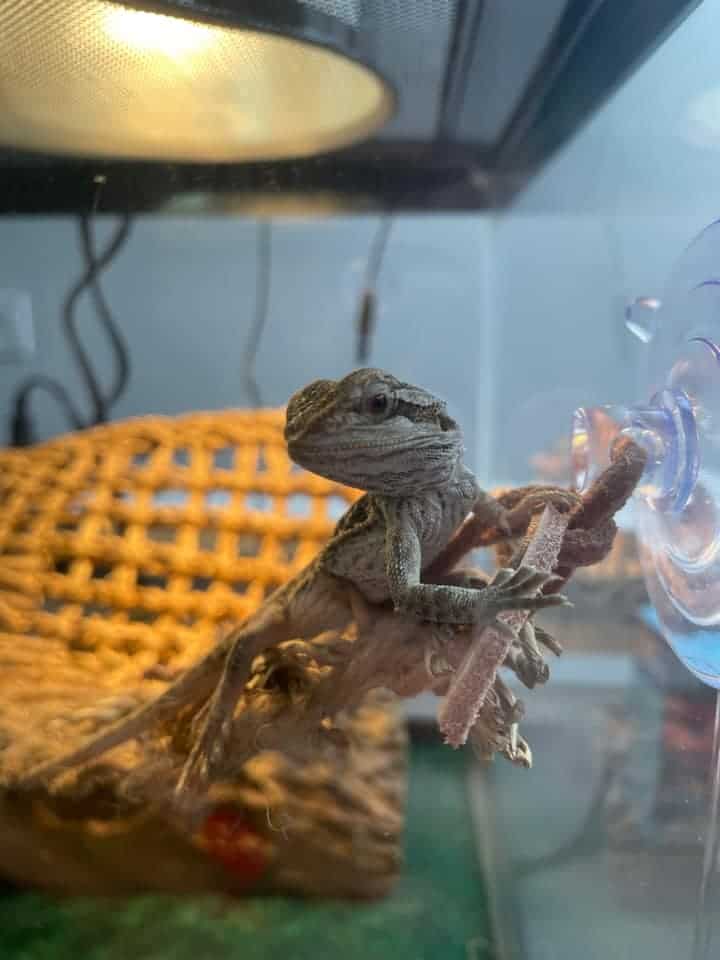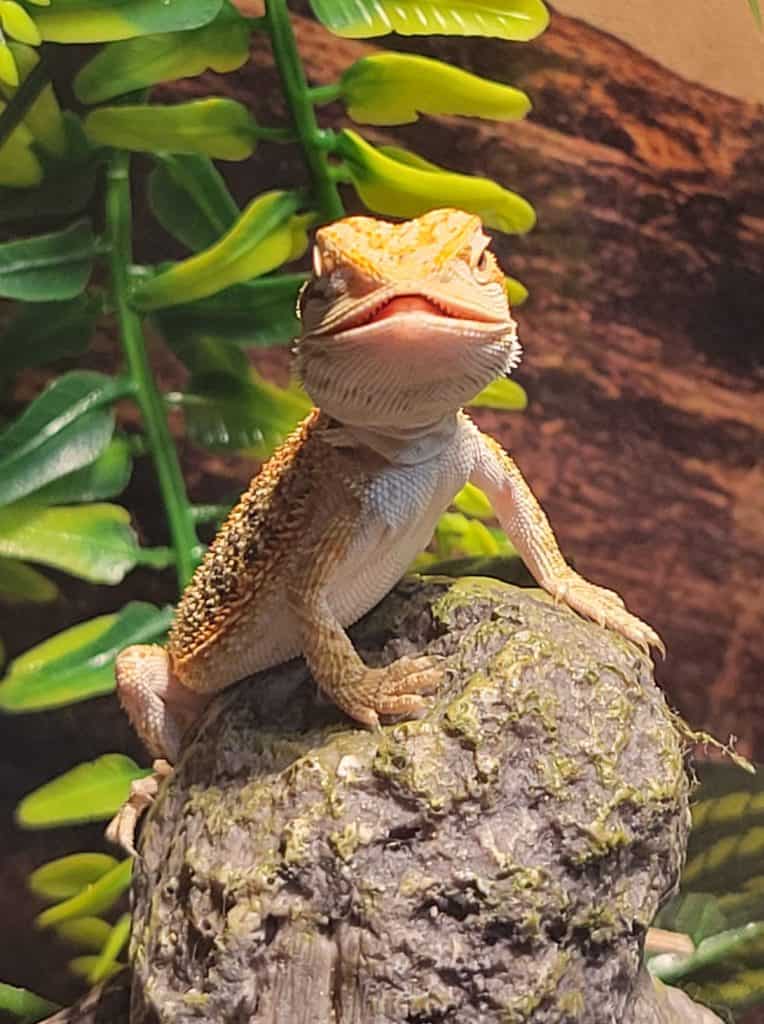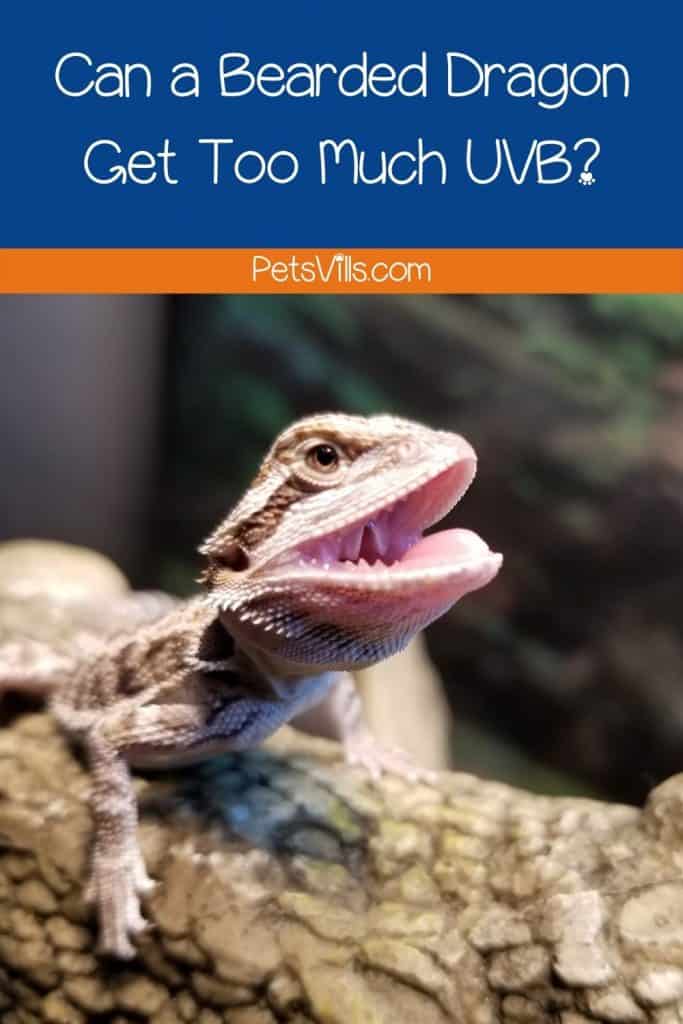Are you questioning if a bearded dragon can get too much UVB? Well, this is a question new beardie owners find confusing. As a bearded owner myself, I try to replicate the beardie’s natural environment/habitat in its terrarium. You should also do it. How do I manage? Find out more.
Table of Contents
Can a Bearded Dragon Get Too Much UVB?
A bearded dragon can indeed get too much UVB in captivity. This particular lizard species requires sufficient amounts of UVB rays in a day.
Too much UVB output has negative effects on the beardies’ skin, eyes, and general health. You should understand the correct lamp setting and the precise bulb to use in the tank.
A lamp placed too close to the tank will emit excess UVB.

Importance of UVB to a Bearded Dragon
Bearded are desert dwelling reptiles. They are adapted to the harsh desert environment. UVB rays help regulate the production and absorption of Vitamin D3 in the skin [1].
Vitamin D3 assists in the utilization of calcium and phosphorous in the beardies body. Calcium is important for muscle contraction, reproductive health & egg development in females, and bone development in babies.
I normally feed my pet beardie vitamin D3 supplements and calcium-rich foods [2] to help boost UVB output. Look [3] at how happy bearded get with their hour of lights.
The sun’s rays are also essential for the breakdown of food into nutrients. Sufficient sunlight helps in growth, blood circulation, healthy metabolism, and warming the beardies body.
Note that calcium and vitamin D3 present in the body will not synthesize without sufficient UVB rays. So exposure to direct sunlight is necessary for this process.
And low calcium levels can lead to Metabolic Bone Disease (MBD).
READ MORE: How to Mount UVB Light Inside Tank
What Are the Risks of Too Much UVB for a Bearded Dragon?
Again, too much exposure to UVB has negative side effects on the beardies body. You should understand the correct amount of UVB exposure to provide for a bearded dragon.
Here are 4 side effects of too much UVB exposure.
1. Hypercalcemia
Excess UVB output can lead to an increase in calcium levels in the beardies body. The increase in calcium levels then leads to raised calcium deposits in the dragon’s kidneys. Thus, hyperparathyroidism disease.
2. Hyperparathyroidism
Excess exposure to UVB will also lead to calcification of vital tissues in the beardies body. You can notice deformity in the dragons’ physical appearance or brittle bone disease.
Unfortunately, hyperparathyroidism often ends up in kidney failure and death.
3. Hyperkeratosis
Excess exposure to natural sunlight radiation will cause skin thickening, lesions, and callouses in a bearded dragon. You should notice a few physical evidence around the mouth and nares/nostrils.
Hyperkeratosis later affects how your pet eats and breathes.
4. Photo-Kerato Conjunctivitis
Photo-Kerato Conjunctivitis is another condition that results from excess UVB exposure. Photo-Kerato Conjunctivitis causes the eyes to swell and become red.
Luckily, this condition is temporary and fades over time. You only need to remove the source of UVB rays for a few hours during the days to deal with this situation.
How Much UVB Does a Bearded Dragon Need?
12-14 hours of exposure to UVB rays is enough for the survival of a bearded dragon.

What Can Cause Too Much UVB?
Poor maintenance of the tank environment is usually the major cause of too much UVB. Placing a UVB lamp close to the bearded dragon, for instance, will cause twice as many rays to hit the tank.
Substandard/poor quality lamps that do not march the size of the aquarium will overheat the beardies tank. Remember: low-quality bulbs emit more UVB rays than what is recommended.
Bearded dragons require “hiding spots” and “cool off zones” to get away from excess UVB rays. They can overstay in the basking area if you do not install a hiding spot in the tank.
Leaving the lights on at night is also another cause of too much UVB in the tank.
Incorrect positioning of the lamp will also increase the level of UVB output. Normally, incorrect lamp positioning happens when the lamp is set on either side of the tank rather than overhead.
Check our comprehensive guide about bearded dragon lighting at night.
Ways of Preventing Too Much UVB
There are four simple ways you should use to protect a bearded from overexposure to UVB output.
1. Purchase quality lamps that match the fixture
Ensure the lamp produces approximately 125 to 150 watts for adult beardies. Mercury vapor lamps are the best alternative lamps to use.
These particular lamps are durable and produce both UVA and UVB rays. Furthermore, always change the vapor bulb after six months.
Watch the video [4] to find out more about UVB bulbs.
2. Install hideouts in the tank
Bearded like hideouts. You should install a precise wooden hideout if you have a bearded held captive. As an expert, I recommend hideouts for your pet’s physical and mental health.
Also, these hideouts normally help your pet regulate its body temperature after exposure to excess UVB output.
3. Correct positioning of UVB bulbs and heaters
Correct positioning of the lamp, UV bulb gradient, and maintaining the appropriate temperature allow your pet bearded to self-regulate in the tank.
However, I do not recommend coil UVB bulbs. These particular bulbs are too strong for a bearded dragon. 10.0 UVB exposure is ideal for a bearded dragon.
4. Follow recommended photoperiod day and night beardie cycle (in captivity) to match the wild environment.
The correct photoperiod schedule will create ideal basking and resting schedule. You can improvise the tank with timers to assist with switching the lights on or off.
Effects of Insufficient UVB Exposure
As much as a bearded can get too much UVB, a bearded can also suffer a few disorders from insufficient UVB exposure. Here are clear signs of insufficient UVB in a bearded dragon.
- MDB (Metabolic Bone Disease) [5]. The beardies’ bones become feeble.
- Beardies become sluggish.
- Lack of appetite.
- Swollen limbs.
- Death (as the last stage).

3 Symptoms of Too Much UVB on Bearded Dragons
When a bearded dragon is exposed to too much UVB, you should notice a few clear signs. Here are three common physical signs of too much UVB to observe.
1. Eyes
The eyes of a bearded dragon are sensitive to light. Thus, when the bearded dragon is exposed to too much UVB, its eyes will swell, become red and cloudy, and close.
Unfortunately, it can be difficult to notice eye cloudiness in a bearded dragon. So, always keep the lamp at a good distance from the beardies tank.
Probably six to eight inches minimum and 12 – 14 inches are maximum.
2. Skin
Hyperkeratosis is the thickening of the outer layer of the skin. When a bearded dragon is exposed to intense UVB rays, its skin thickens.
Visual evidence of excess UVB (what to notice): Skin lesion, skin clumping (near the eyes and mouth), and skin darkening.
3. Behavior
A bearded dragon will hastily evade the light source if it has had enough. It will retreat to the cool-off zone. Again, if the dragon suddenly becomes sluggishly, it could be a sign of excess UVB output in the tank.
This sluggish behavior is also known as lethargy.
FAQs
What are some consequences of too much UVB to my bearded dragon?

When you expose a bearded dragon to too much UVB, you risk burning its skin or damaging its eyes.
And some other health complications like hyperparathyroidism, hypercalcemia or photo-kerato-conjunctivitis.
What are the best UVB bulbs for my bearded dragon?
There are different bulb brands in the market. However, only use the best UVB lights for bearded dragons. I personally use incandescent heat bulbs for the basking areas and mercury vapor bulbs for UVB output.
How to cool my bearded dragon if it has received too much UVB?
You need to install shallow water bowls for it to soak if there is an increase in temperature in the terrarium. Additionally, mist the tank or install a moist hide accessory in the tank.
Conclusion
So, can a bearded dragon get too much UVB? Yes! Be careful with your beardie pet and turn on a good UVB bulb during the day.
Also, pay attention to their body language, because they may show symptoms of inappropriate UV output. Following these tips, your beardie will be healthy and happy!

Can a bearded dragon get too much UVB? Let us know your opinion on this topic below!
References
- 1. University of Illinois Urbana‐Champaign. Pet Reptiles Need Vitamin D and Calcium for Bone Health [Internet]. College of Agricultural, Consumer and Environmental Sciences. 2004. Available from: https://aces.illinois.edu/news/pet-reptiles-need-vitamin-d-and-calcium-bone-health
- 2. Axelson R. Bearded Dragons – Feeding [Internet]. vca_corporate. 2017. Available from: https://vcahospitals.com/know-your-pet/bearded-dragons-feeding
- 3. Keatinge R. Basking bearded dragon [Internet]. YouTube. 2015. Available from: https://www.youtube.com/watch?time_continue=31&v=SR0Ras0tWj4&feature=emb_logo
- 4. Pisces Pets. What UVB Bulb Should I Use?! REPTILE BASICS [Internet]. www.youtube.com. 2020 [cited 2022 Feb 7]. Available from: https://www.youtube.com/watch?v=aA5_6EoCkYQ&feature=emb_imp_woyt
- 5. Axelson R. Bearded Dragons – Diseases [Internet]. vca_corporate. Available from: https://vcahospitals.com/know-your-pet/bearded-dragons-diseases#:~:text=MBD%20is%20generally%20caused%20by
Alina Hartley is a small-town girl with a ginormous love of bearded dragons. It all started with Winchester, a baby bearded who was abandoned at the shelter by his former owners because of a birth defect that caused one front leg to be shorter than the other. Alina originally went to the shelter looking for a guinea pig, but one look at Winchester and it was love at first sight. From that day on, Alina has dedicated her life to learning everything she can about bearded dragons. She loves helping new beardie parents start their incredible journey with these magnificent reptiles.
Follow her on:
LINKEDIN
TWITTER.
Read her latest articles HERE
Learn more about her HERE.


